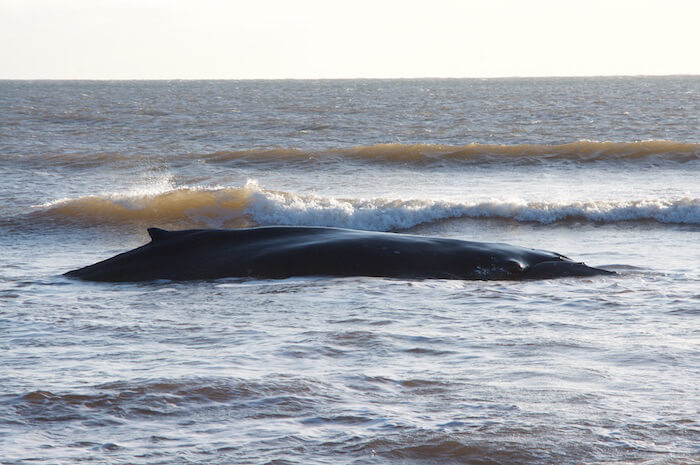By François Vachon
Ocean water exerts pressure that allows cetaceans to support their mass. Animals such as fin whales and humpback whales can weigh 40-50 tonnes and 25-35 tonnes, respectively. The blue whale – which measures up to 28 m long – is the largest animal on Earth. It weighs between 75 and 130 tonnes. Specifically, these animals would be unable to survive out of the water because their skeleton would collapse under their own weight.
When a whale becomes stranded near shore, it struggles to regain its freedom of movement and return to the open sea. If its body remains in contact with a hard surface for an extended period of time, its ribcage becomes compressed by its own weight. Due to ensuing breathing difficulty and reduced blood flow, its internal organs and muscles gradually deteriorate. Necrotic tissues then generate toxins that trigger a generalized infection, which leads to death.
Individual whale strandings
We often hear about mass whale strandings. But what about strandings of isolated individuals? Even if their cases are also still not fully understood, there are a number of explanations. For example, an individual may run ashore if it is lost, disoriented, sick, injured, suffers from an infection, etc. Additionally, a young animal that has recently weaned or weaned prematurely may find it difficult to fend for itself and take the wrong route due to a lack of experience.
Human activity can obviously cause strandings. One needs only to think about the infamous entanglements in fishing gear, collisions with boats, or the numerous disturbances caused by humans (military sonar, noise pollution, boating, commercial shipping, etc.). It should be noted, however, that strandings due to human activity often result in the death of the animals. According to the website of the International Fund for Animal Welfare (IFAW), in the last 10 years, nearly 7% of marine mammals stranded in the area monitored by the organization have reportedly been victims of some form of interaction with humans.
Rescue attempts in event of stranding
Incidents involving live stranded whales require a thorough examination of the situation, which is the first step in a decision-making process established by Fisheries and Oceans Canada. The said process is based on several criteria, including the animal’s health status, logistics organization and resource availability. “These rescue attempts are very risky and require complex logistics. Indeed, given the size of the whale and how powerful it is, it is highly risky to handle these animals, move them or even euthanize them, since the latter requires a large dose of barbiturates that must be handled with caution,” points out Josiane Cabana, Director for the Quebec Marine Mammal Emergency Response Network call centre. Questioned about the humpback that was found last Sunday near the shore of Étang-du-Nord in the Magdalen Islands, she adds: “A whale of this size does not usually survive very long in such a situation on account of its weight, which compresses its ribcage. The whale was visibly thin and its chances of survival were considered to be nil, even if it had been transported offshore.”
If you witness an incident involving a seal or whale in difficulty, or if you see a carcass at sea or on shore, please contact the Quebec Marine Mammal Emergency Response Network at 1-877-7baleine (1-877-722-5346). An attendant will answer your call and take note of any relevant information. The service is available 24 hours a day, 7 days a week.





